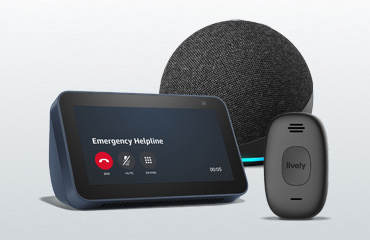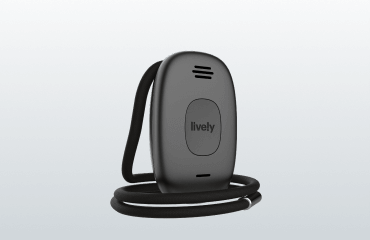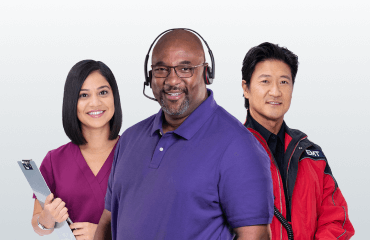If you have ever experienced a fall, or know someone who has, you know that time is of the essence to obtain help. While a fall can occur at any age, the threat for falls increases as we age. Even falls without injury can affect you psychologically.
...over a quarter of all seniors over the age of 65 suffer a fall each year.
It may be surprising to learn that over a quarter of all seniors over the age of 65 suffer a fall each year. Falls can cause broken bones, head injuries, and fear of future falls. In fact, up to 95-percent of hip fractures are the result of falling, says the Centers for Disease Control and Prevention (CDC).
A medical alert system can create a level of safety at the touch of a button by delivering fast medical support when you’re alone. These life-saving devices enable seniors and those with medical concerns to maintain their independence by allowing them to age in place by providing safety and peace of mind.
Since there are many options to choose from, deciding on a service can be overwhelming. Luckily, it doesn’t have to be. Here are a few tips on choosing the right system for you.
What is a medical alert system?
One of the best ways that seniors can stay independent and overcome fear of fall injuries is to invest in a medical alert system. A medical alert system, often called a personal emergency response system (PERS) or fall button, is a combination of state-of-the-art communication and computer technology. There are two types of systems available: in-home systems and mobile systems.
These easy-to-use communication tools allow seniors to remain living safely in their homes as long as possible. After all, the risk of falling should not discourage you from your favorite physical and social activities.
How do medical alert systems work?
An in-home medical alert system has two components, a console and a pendant with a button. Your home is monitored electronically by a base unit that is plugged into a standard wall outlet and telephone jack. The help button (pendant) is worn around your neck, on your wrist, or on your belt. For the mobile option, you only need the help button, and no base station is needed. If an emergency occurs, you simply push the personal help button on the pendant which then alerts the U.S.-based call center. A live agent at the call center will then call emergency medical personnel or your emergency contact numbers. Call centers operate 24 hours a day, 7 days a week, and callers will always be connected directly to a live agent. Some voice-activated smart home assistants now even allow you to simply call out for help with no need to carry around a mobile device.
Medical alert system users
A medical alert system is an excellent investment for seniors who live alone and especially for those who want added protection in the event of an emergency, and may be a wise choice for anyone who:
Wants to remain independent and continue doing activities they love with an added level of security.
Has a fear of falling at home or on the go.
Has poor hearing or eyesight.
Has declined cognitive function like those with Alzheimer’s and other forms of dementia.
Is recovering from surgery or other medical procedures.
Lives with a difficult-to-manage disease like epilepsy and diabetes.
Takes medication that may make them faint, dizzy, or sleepy.
Lives alone and wants an added sense of security.

Benefits of a medical alert system
There are many benefits to owning a medical alert system.
Allows independence. There both at-home and portable options so that you can remain independent and live comfortably within your home longer without having to depend on others to check on you regularly.
Quick assistance. A rapid response to falls and other health emergencies is vital to prevent serious injuries and preserve your independence.
Tailored to your needs. There are many different systems on the market that cater to your individual needs and activity levels.
Easy to use. One of the best things about medical alert devices is their simplicity. Easy set-up and a one-push help button ensure a user-friendly system, even in the dark for people who are visually impaired.
A rapid response to falls and other health emergencies is vital to prevent serious injuries...
Provides expanded service. During an emergency, a cell phone may not be available to call for help. Wearable devices allow you to have an alert button with you at all times, even in the shower.
Assistance anywhere. Some medical alert systems offer at home and GPS-enabled options, so you can stay safe anywhere. If emergency assistance is needed, you can speak immediately to skilled emergency medical staff through a 2-way voice communication device with a push of a button.
Discreet. Medical alert equipment includes portable alert buttons that users can wear inconspicuously on their belts or wrists, and even around their necks.
Affordable options. Some system providers offer an affordable option for under $30 per month, while still delivering important assistance day and night.
Works without power. Medical alert equipment provides reliable assistance by running on long-lasting batteries, even during a blackout or storm.
Peace-of-mind. A medical alert system can help you feel better knowing you are safe to be alone because you have access to emergency assistance 24 hours a day, seven days a week, if you need it.
Primary functions of a medical alert system
There are several medical alert brands and models available, with many options based on your needs and price point. Some of the basic options to look for when deciding on a monitoring system include:
Monitoring features. This consists of a lightweight help button pendant, a base station (for in-home), and a call center that assists in emergencies.
Equipment. The base station range/cellular coverage, long-life battery power, and battery back-up are important equipment features.
Connectivity. Connectivity differs between medical alert systems, and most companies accommodate for landline, VoIP, and cellular technology.
Customer service and support. If you need assistance, the top systems offer U.S.-based customer service representatives and technical support professionals for all your needs.
Pricing and contracts. Pricing can be challenging, given the many options available. A straightforward plan without annual contracts or cancellation fees are the best.
Added features. For additional costs, features like GPS tracking, fall detection, daily activity monitoring, daily check-in services, fitness tracking, medical monitoring, access to a live nurse or board-certified doctor, personal directory assistance, a caregiver smartphone app, and carbon monoxide detection can increase the value of the system.
Which medical alert system is right for you?
When selecting a medical alert system, start by assessing your current and future needs and abilities. The most valuable system offers reliable equipment, a clear pricing structure, and quick assistance. Several factors to consider while evaluating medical alert systems include cost, service agreement, features, durability, and support availability.
Should an emergency occur, a medical alert system is there to keep you safe and deliver peace of mind that you are safe and protected, with just the push of a button.
Here’s more from Lively.
swipe for more
scroll or use your arrow keys for more
scroll for more
use your arrow keys for more



